When you’re searching for a heavy-duty portable power station, it’s all about finding the right balance between power, price, and features. The Anker Solix F3800 stands out as a top contender, offering robust energy storage, fast charging, and the ability to keep your essential devices running when it matters most.
Whether you’re preparing for an emergency or setting up off-grid power for your RV, this in-depth review will walk you through everything you need to know about the F3800. You’ll have the knowledge and details you need to make the best decision for your situation.
Let’s jump into this Anker F3800 review.
We carefully select the products and services we link to. If you buy through our links, we may earn a commission. There’s no extra cost to you and it helps us provide this information.

Powerhouse Perfection: The Anker Solix F3800
Anker knows a thing or two about creating reliable and impressive portable energy systems. It’s been producing high-quality batteries focused on portability since 2011. The Anker F3800 is the preeminent showing of this brand’s ability to take things up a notch and provide incredible whole-home power systems.
As one of the industry’s largest and more capable power stations, the Solix F3800 stands tall as a heavy-duty solution. It’s packed with impressive features like multiple high-amp and 240V outputs, intelligent software and app connections, and massive modular expansion abilities.
Anker tops things off with the Anker Home Power Panel, an automatic transfer switch that can combine your grid power with the F3800 battery backup and solar panels.
Here are our top reasons for why the Anker Solix F3800 is a game-changing power station:
- Massive 3.84kWh internal battery capacity
- Powerful 6,000W inverter to handle heavy-duty appliances
- Modular system can reach 53.8 kWh battery and 12kW AC output
- High-amp outputs ready to deliver big RV or whole-home power
We have a lot of great things to say about the F3800 because it deserves it. But we’re also not afraid to point out the areas where it could use some improvement. Here are the downsides to this heavy-duty system:
- Low voltage solar inputs: More challenging to maximize its full solar potential
- Large and heavy: As with any system of this magnitude, it’s not the easiest to move around
- Higher initial investment: Anker provides excellent value, but energy independence is a costly endeavor
For users seeking dependable power without the constant hum and fuel cost of gas generators, the Anker Solix F3800 is an ideal solution. It’s a smart choice for homeowners looking to break free from power interruptions or adventurers who need a reliable energy source wherever they go. There’s almost no limit to the battery size and it has enough power to run an entire house of appliances at the same time.

|
Anker Solix F3800 Portable Power Station |
F3800 on Anker F3800 on Amazon |
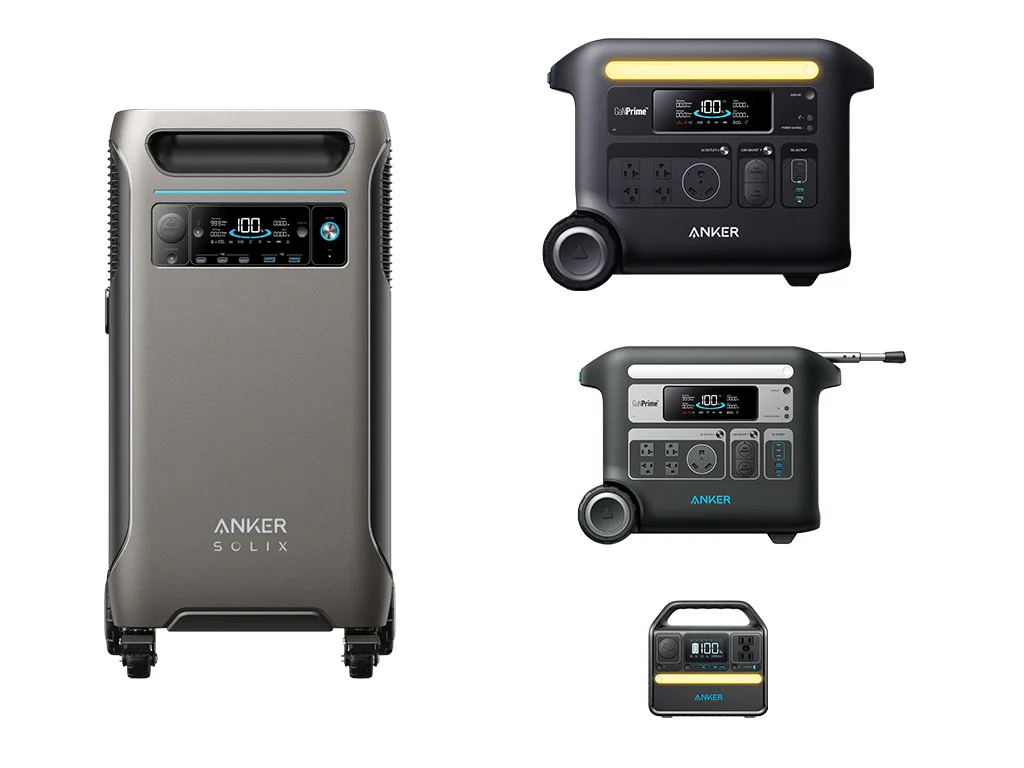
The F3800 Compared to Other Power Stations
Within Anker’s power station lineup, the Solix F3800 takes the crown as the biggest and most robust system available. The F2600 is the next most powerful but it has a maximum battery capacity of just 4.6kWh, a fraction of the F3800’s potential.
Other Anker systems include one of our favorite midrange systems, the C1000, as well as many compact power stations that offer a small energy boost at a low price, like the Anker 521.
The F3800 excels in delivering sustained power for larger setups, making it perfect for homes, RVs, and other off-grid applications where you need more than just a little extra juice. Below is a quick Anker comparison chart to see how the F3800 stacks up against its siblings.
| Product | Battery | Battery (System Max) | AC Output | AC Output (System Max) | Buy Now | Buy on Amazon |
|---|---|---|---|---|---|---|
| Anker Solix F3800 | 3,840Wh | 53,760Wh | 6,000W | 12,000W | Buy Now | F3800 on Amazon |
| Anker Solix F2600 | 2,560Wh | 4,608Wh | 2,400W | 2,400W | Buy F2600 | F2600 on Amazon |
| Anker Solix F2000 / PowerHouse 767 | 2,048Wh | 4,096Wh | 2,400W | 2,400W | Buy Now | Buy on Amazon |
| Anker Solix F1500 | 1,536Wh | 1,536Wh | 1,800W | 1,800W | Buy Now | Buy on Amazon |
| Anker Solix F1200 / PowerHouse 757 | 1,229Wh | 1,229Wh | 1,800W | 1,800W | Buy Now | Buy on Amazon |
| Anker Solix C1000 | 1,056Wh | 2,112Wh | 1,800W | 1,800W | Buy Now | Buy on Amazon |
| Anker Solix C1000X | 1,056Wh | 2,112Wh | 1,800W | 1,800W | Buy Now | Buy on Amazon |
| Anker PowerHouse 555 | 1,024Wh | 1,024Wh | 1,000W | 1,000W | Buy Now | Buy on Amazon |
| Anker PowerHouse 535 | 512Wh | 512Wh | 500W | 500W | Buy Now | Buy on Amazon |
| Anker PowerHouse 522 | 299Wh | 299Wh | 300W | 300W | Buy Now | Buy on Amazon |
| Anker Powerhouse 521 | 256Wh | 256Wh | 200W | 200W | Buy Now | Buy on Amazon |
| Anker PowerHouse 511 | 87.6Wh | 87.6Wh | 100W | 100W | Buy Now | Buy on Amazon |
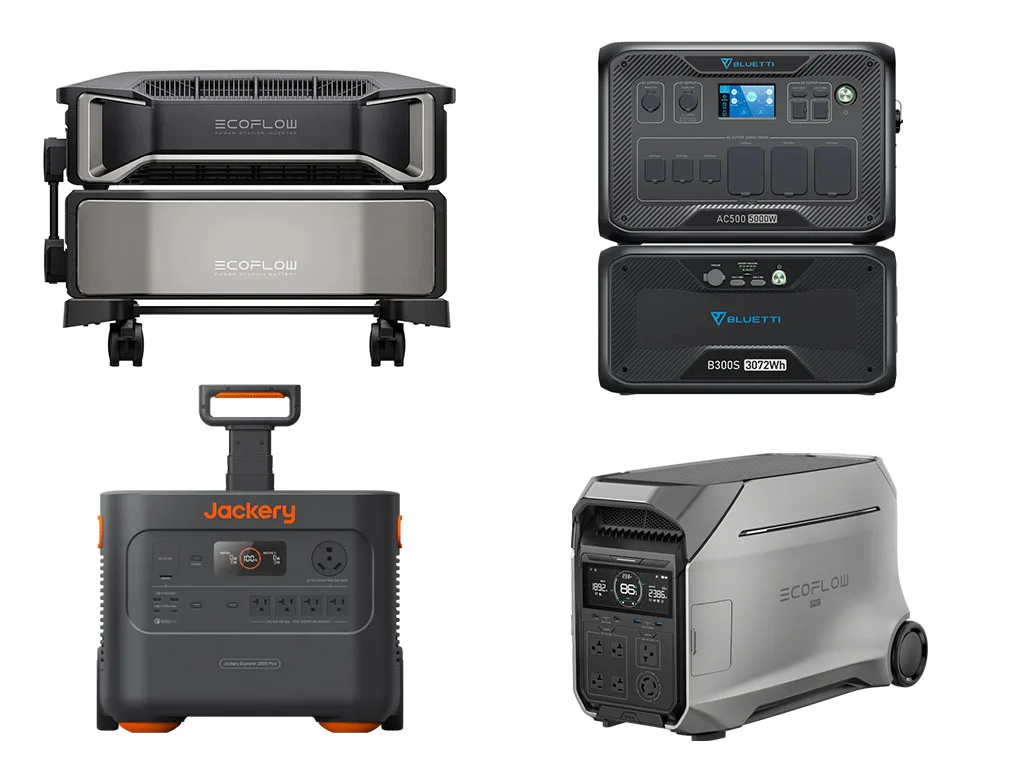
Looking at the wider power station market, the Anker F3800 is still toward the very top of the charts. The only glaring exception that outdoes the Anker F3800 is the EcoFlow Delta Pro Ultra. That is a chart-topping monster with single-unit specs of 6kWh per battery and 7.2kW AC output.
Outside of that, there are a handful of units that are more directly comparable to the F3800. Here’s our short list of the best alternatives along with links to our in-depth reviews on each:
- EcoFlow Delta Pro 3: An amazing and innovative system with similar 240V outputs and 12kW max system. Includes better solar charging abilities but lower maximum battery size. Very attractive option.
- Bluetti AC500: Slightly smaller all-around very powerful system. Includes high-amp DC output missing from many alternatives, great for powering DC fuse boxes.
- Jackery 2000 Plus: Significantly lower than most on this list although it’s Jackery’s largest option. Still designed to provide whole-home backup energy.
The Delta Pro 3 is one of our favorite all-around systems. We’ve compared the Delta Pro 3 and F3800 here so you can see how closely these match up.
| Product | Battery | Battery (System Max) | AC Output | AC Output (System Max) | Buy Now | Buy on Amazon |
|---|---|---|---|---|---|---|
| Anker Solix F3800 | 3,840Wh | 53,760Wh | 6,000W | 12,000W | Buy Now | F3800 on Amazon |
| EcoFlow DELTA Pro Ultra | 6,000Wh | 90,000Wh | 7,200W | 21,600W | Buy DPU | EcoFlow DPU on Amazon |
| EcoFlow DELTA Pro 3 | 4,096Wh | 36,864Wh | 4,000W | 12,000W | Buy DP3 | Buy on Amazon |
| Bluetti AC500 | 3,072Wh | 36,864Wh | 5,000W | 10,000W | Buy AC500 | Bluetti AC500 on Amazon |
| Jackery Explorer 2000 Plus | 2,043Wh | 24,516Wh | 3,000W | 6,000W | Buy 2000 Plus | 2000 Plus on Amazon |

|
EcoFlow DELTA Pro 3 |
DP3 on EcoFlow DP3 on Amazon |
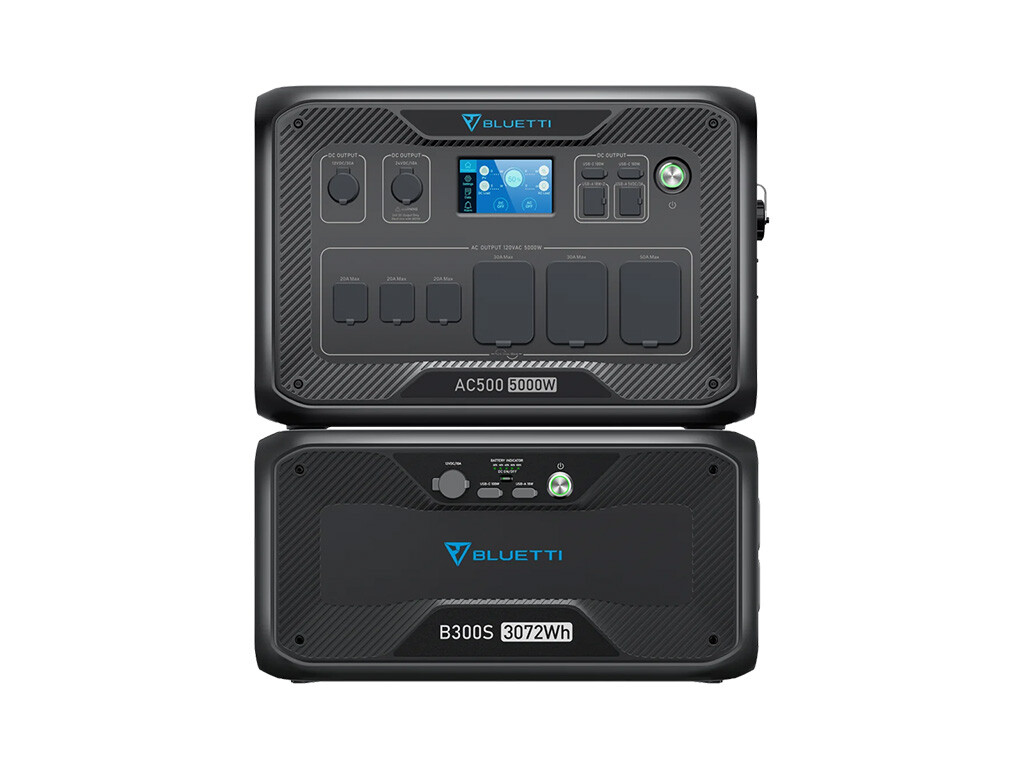
|
BLUETTI AC500 |
AC500 on Bluetti AC500 on Amazon |
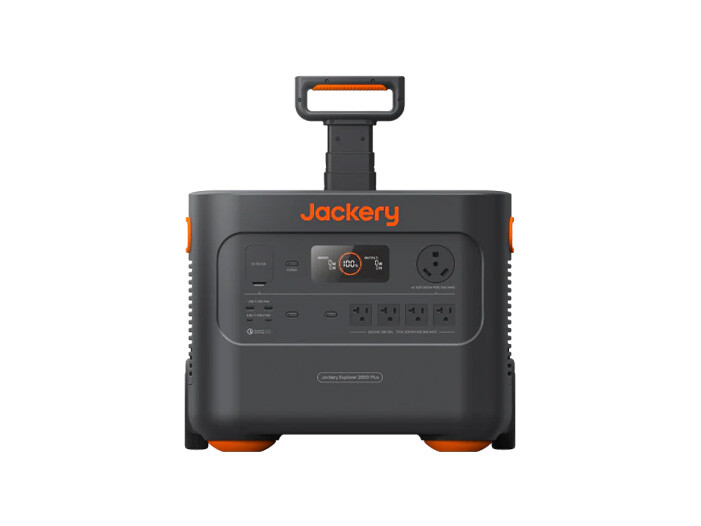
|
Jackery Explorer 2000 Plus |
2000 Plus on Jackery 2000 Plus on Amazon |
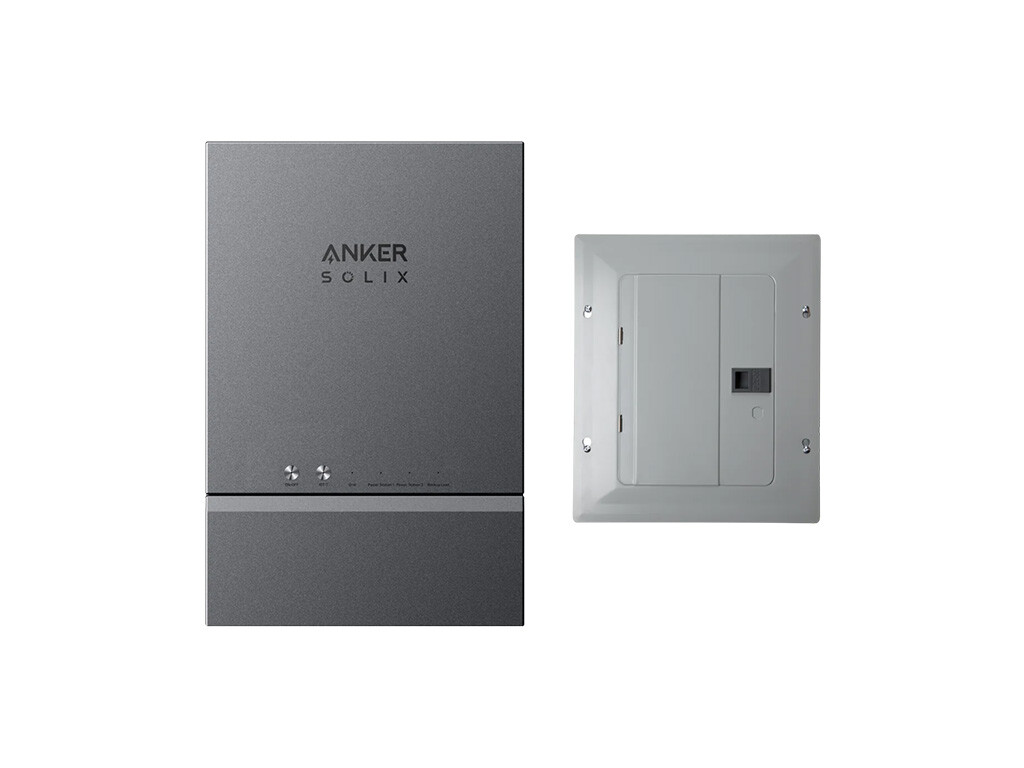
Best Uses for the Anker Solix F3800
The Anker Solix F3800 isn’t just for casual use. This power station allows you to take control over your energy. No more worrying about the status of the utility company or the next incoming storm. It’s designed for those looking to achieve energy independence.
You can also use it to reduce electricity bills by storing solar power and using it during peak energy times. If your goal is to keep your home running smoothly during power outages or to power your RV or off-grid cabin with ease, this is the station that can handle it all.
Since it has a battery that’s over 3kWh, it may qualify for the solar tax credit. That’s a whopping 30% back from the F3800 purchase, including accessories and solar panels.
There are many ways to integrate the F3800 directly into your home circuits:
- Anker Home Power Panel: Our favorite automatic switch and subpanel with many intelligent features
- Universal Automatic Transfer Switch: Slightly less sophisticated way to manage grid and battery backup
- Manual transfer switch with critical loads panel: A standard way to safely integrate battery backup power
- Generator inlet: The most simplistic solution that requires careful use to avoid overloading your power station and backfeeding the grid (need to use interlock)
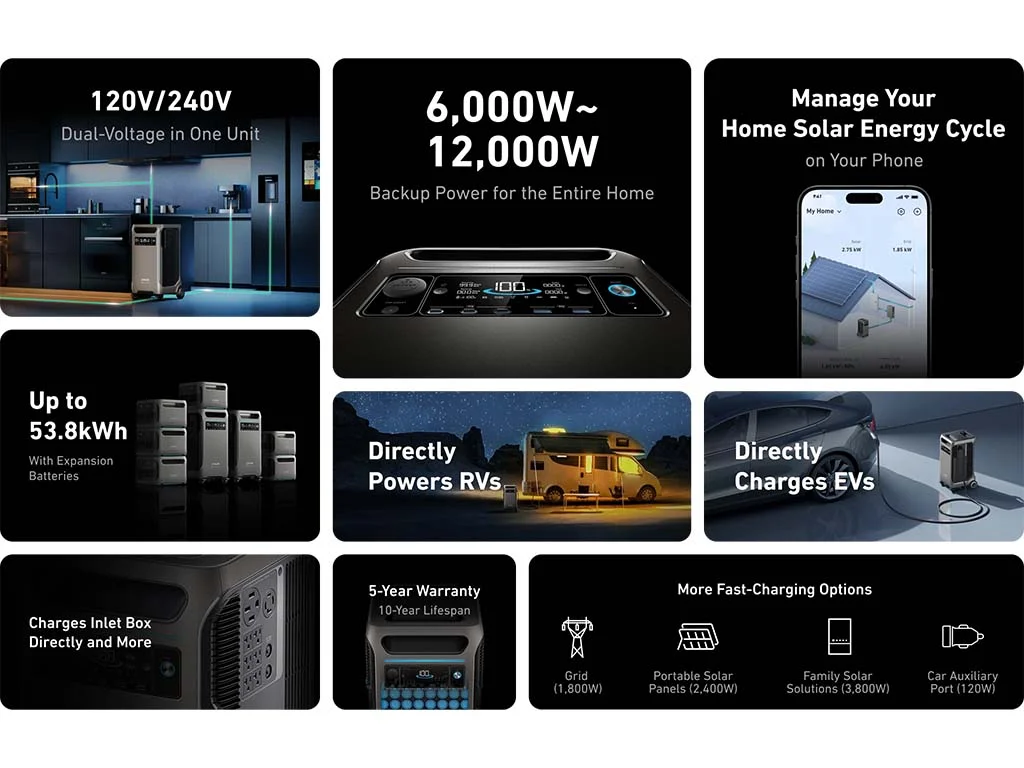
The Anker Home Power Panel is by far the best choice. It’s an innovative and intelligent choice designed specifically to work with the F3800 and it provides unparalleled control and information. It’s an automatic transfer switch that detects grid outages and rapidly switches over to the F3800’s battery supply. You can also control charging parameters and much more through the Anker app, no matter where you are in the world.
If you are using it for RV use, you can simply use its 30-amp or 50-amp outputs to feed directly into your existing shore power inlet. No need to fuss with anything else. If you want, you could add a secondary shore power inlet so that you can choose between the F3800 or a different shore power source without unplugging the F3800.
With the Anker F3800, you can find peace of mind during emergencies, a solution for lowering energy costs, or the ability to go fully off-grid. This power station is a reliable, efficient, and expandable option. Whether it’s keeping your lights on during a storm or running your appliances in the wild, the F3800 is designed to solve your energy problems.

|
Anker SOLIX Home Power Panel |
Buy on Anker |
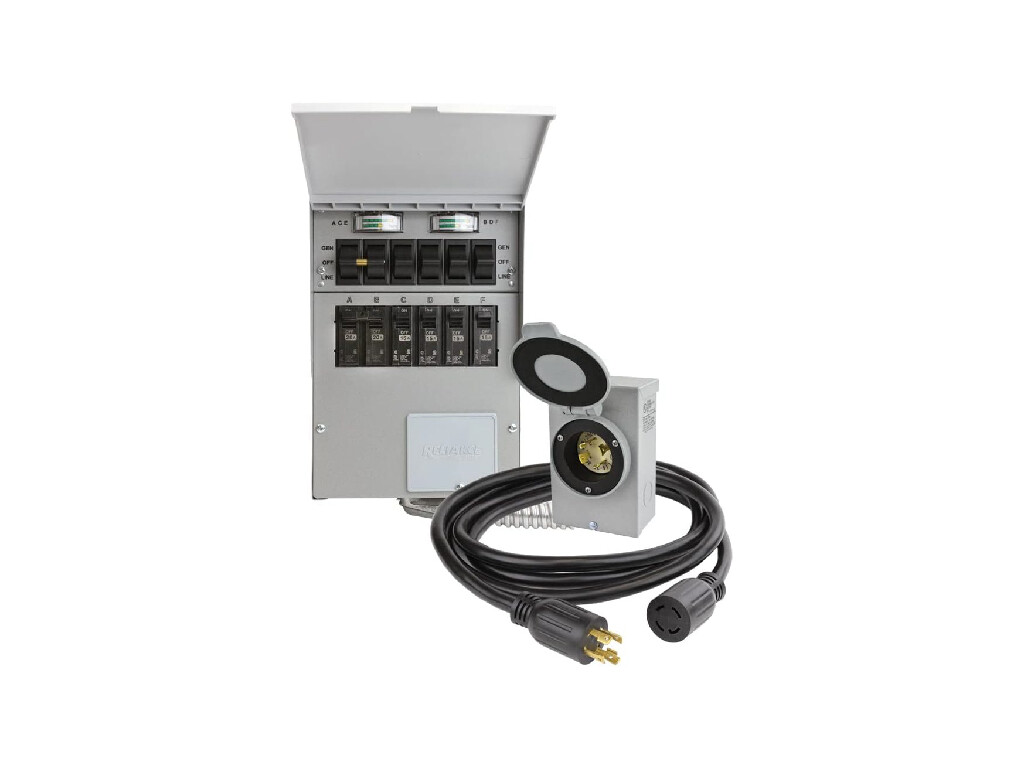
|
Reliance Controls 306CRK Transfer Switch Kit |
Buy on Amazon |
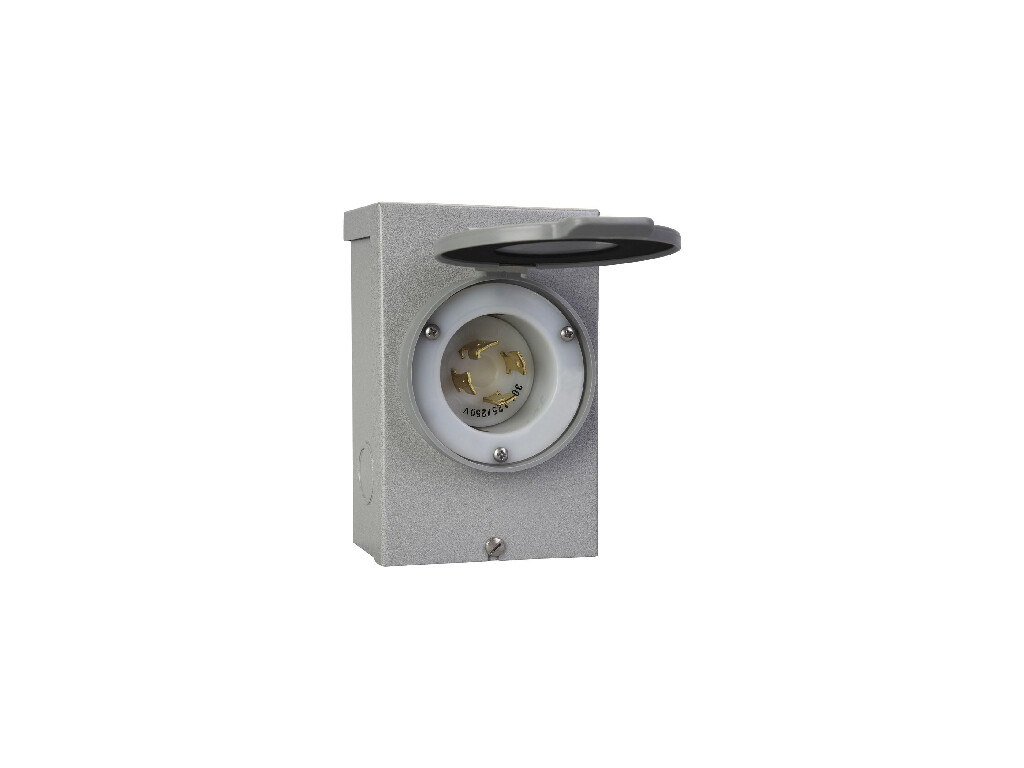
|
Reliance Controls PB30 30-Amp Generator Inlet Box |
Buy on Amazon |
In-Depth Review: Anker Solix F3800
We’ve done a quick overview and now it’s time to take a close look. This guide will not only show the key features and specs, but we’ll also help you understand the real-world implications and meanings. You’ll be able to know exactly what the F3800 is capable of as well as what it can’t do.
Below is the list of how we’ll go through the Anker Solix F3800’s key performance aspects:
- What Can It Handle? Inverter Power and Outputs
- How Long Will It Last? Battery Capacity and Lifespan
- How Fast Does It Recharge? Charging Speed and Inputs
- How Easy Is It to Move? Portability and Dimensions
- Final Verdict Summary and Recommendation
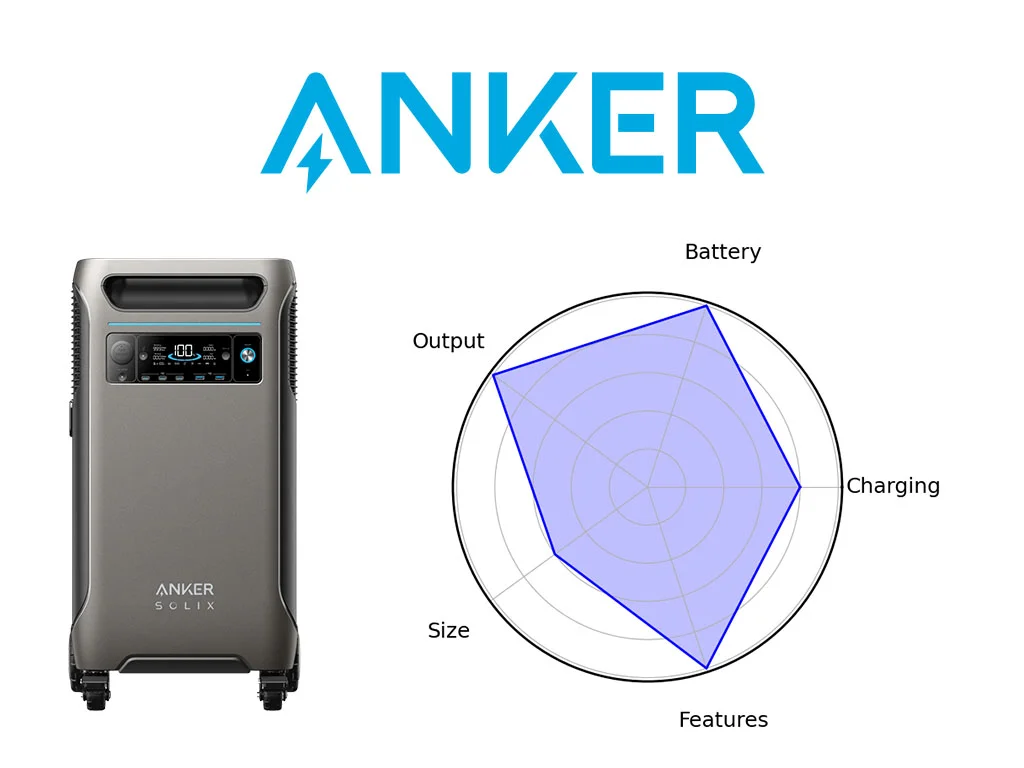
Powering Your World: Inverter and Outputs
When it comes to portable power, the Anker Solix F3800 delivers versatility for every situation. Yet the starting point to any power station purchase is to make sure it can power the devices you have in mind. The inverter and outlets are what ultimately determine what you can run.
What exactly does the inverter do? In short, it’s the workhorse behind the scenes, converting the DC (direct current) stored in the battery into AC (alternating current) power. Standard wall outlets use AC energy and it’s also what many household devices need to run. USB ports offer a DC output that can use the battery energy directly, without involving the inverter.
The F3800 comes equipped with a 6,000W continuous inverter. This is a very capable inverter that’s only outdone by the Delta Pro Ultra. You can run a big handful of electronics at the same time.
Here’s a quick rundown of basic devices and their typical running wattage:
- Full-size refrigerators (~500-800W)
- Televisions (~100-250W)
- WiFi routers and modems (~20-40W)
- Laptops and computers (~50-200W)
- Portable heaters (~1,500W)
- Power tools (~800-2,000W)
- Air conditioners (~3,000W and up)
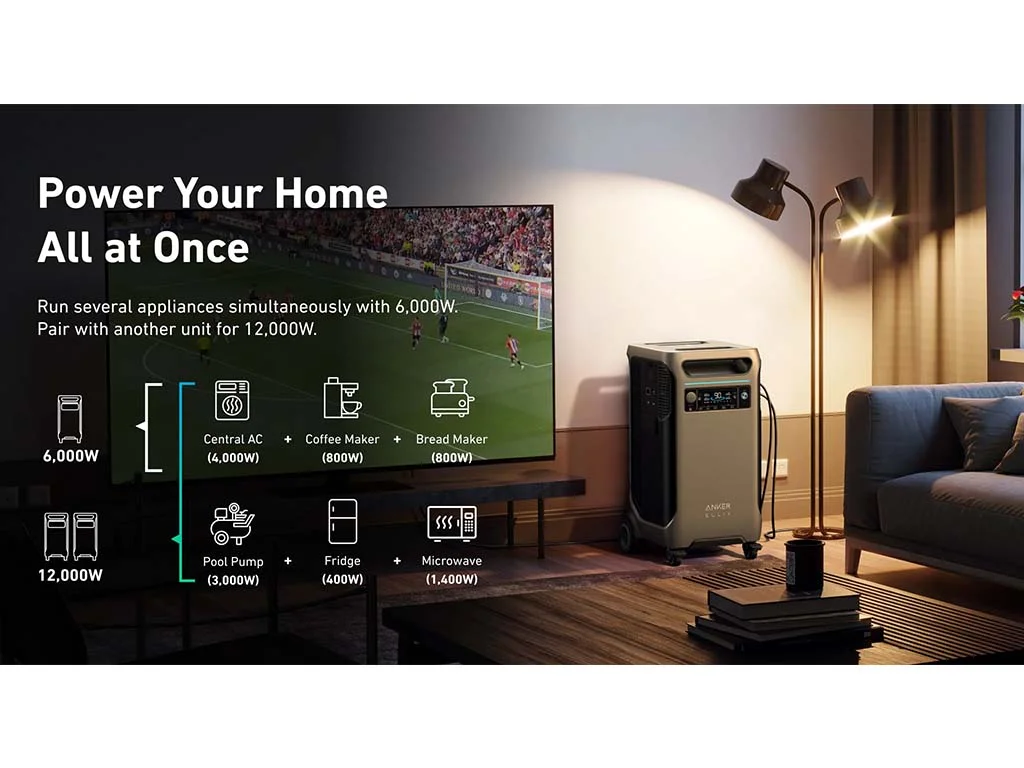
With a power station like the F3800, you’re not limited to just one or two devices. Whether you’re charging phones, powering a laptop, or keeping the lights on and fridge cold during a blackout, it has you covered. There are also DC and USB outputs to handle smaller electronics like phones and tablets, keeping everything powered and connected without a hitch. You can always use the AC outlets for those too.
Some restrictions start to pop up when you’re using certain heavy-duty appliances like air conditioner units. These not only require a lot of constant energy, they also have big startup surges. A soft startup device can help mitigate these startup surges.
If you need more than 6kW, you can use two F3800 units together to generate a whopping 12kW of energy. That’s capable of handling almost any home power situation. Make sure you also carefully consider the battery size which determines how long it will run (next section).
The number and types of connections are also crucial to consider. Here is a look at the F3800’s outlets and ports:
- AC outlets: Six standard household 120V plugs, including three with <20ms UPS function.
- High-amp ports: Two high-amp ports including the L14-30R and 14-50, both of which can run on 120V or 240V configurations.
- DC outlets: Five USB ports ideal for phones, tablets, and other small electronics.
One feature missing from the F3800 is a high-amp DC output. Some power stations like the Delta Pro 3 and Bluetti AC500 offer a 30-amp DC output, usually from an Anderson connection. These are great for powering DC fuse boxes and avoiding the use of the inverter (which consumes some energy to run).
Output Summary: The Anker Solix F3800 offers one of the most versatile and powerful inverter setups available from a portable power station. With a 6,000W continuous rating and max two-unit system capacity of 12,000W, it handles a wide range of devices effortlessly. The abundance of outlets provides a lot of flexibility, especially through the 30-amp and 50-amp connector types. The only thing missing is a high-amp DC output.
| Product | Anker Solix F3800 |
|---|---|
| AC Output | 6,000W |
| AC Output (System Max) | 12,000W |
| 120V Outlets | 6x20A |
| 240V Outlets | 2x25A (L14-30R & 14-50) |
| UPS / EPS | 20ms |
| USB-A Ports | 2x12W |
| USB-C Ports | 3x100W |
| Other DC (Anderson or other) | – |
| Connectivity | WiFi / Bluetooth |

Power That Lasts: Battery Capacity and Performance
Battery capacity is measured in watt-hours (Wh). It tells you how long the Anker Solix F3800 can keep your devices running. For example, with its impressive 3,840Wh capacity, you can power a 60W laptop for roughly 40 hours.
You can determine this runtime for your devices and any battery size with a simple formula. The battery watt-hours divided by the running wattage of the devices provides the number of runtime hours. Factor in real-world conditions and expected system inefficiencies (heat, inverter use, unusable battery space) by reducing the hours by about 20%. Wh / W x 0.8 = Estimated hours of runtime.
How long can the Anker F3800’s battery last? The 3.84kWh internal battery alone can:
- Charge a 10Wh phone ~300 times
- Charge a 60Wh laptop ~50 times
- Power a full-size fridge, 50” television, or desktop computer for ~15 hours
- Power a microwave, hairdryer, or coffee maker for ~3 hours
- Power a whole-home air conditioner for ~1 hour
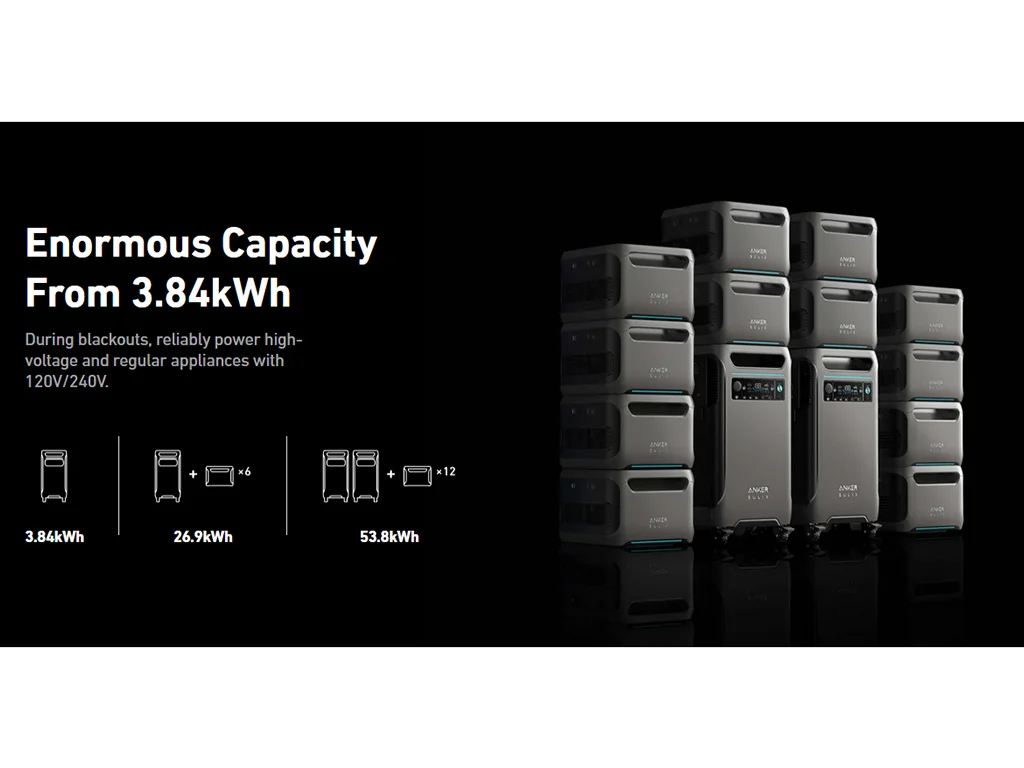
These real-world numbers give you a practical sense of how long the F3800 can support essential items during camping trips, RV adventures, or emergency home backup. Just remember that when you add up the devices at the same time, the time begins to shorten. Yet it can still easily power a handful of lights and small devices, plus your TV and fridge for upwards of 10 hours. Just from one F3800 unit.
If you need even more capacity, each F3800 can use up to 6 additional battery units. And since you can use two F3800 units together, that’s 12 extra batteries with a total battery capacity of 53,760Wh. With this expanded capacity, you could power your entire home for days at a time. The F3800 is not just a backup option, but a long-term energy system.
The F3800 features LiFePO4 batteries (Lithium Iron Phosphate) rated for at least 3,000 charging cycles while keeping 80% of its capacity. And it’s backed by a long 5-year warranty. This power station is a long-term investment backed by long-lasting technology and purchase protection.
Battery Summary: With its large 3,840Wh battery and expandable capacity up to 53,760Wh, the Anker F3800 battery is made for serious power needs. It can run bigtime appliances for days on end, as long as you get the right amount of batteries.
| Product | Anker Solix F3800 |
|---|---|
| Battery | 3,840Wh |
| Battery (System Max) | 53,760Wh |
| Warranty | 5 years |
| Battery Type | LiFePO4 / LFP |
| Battery Cycles | >3,000 |
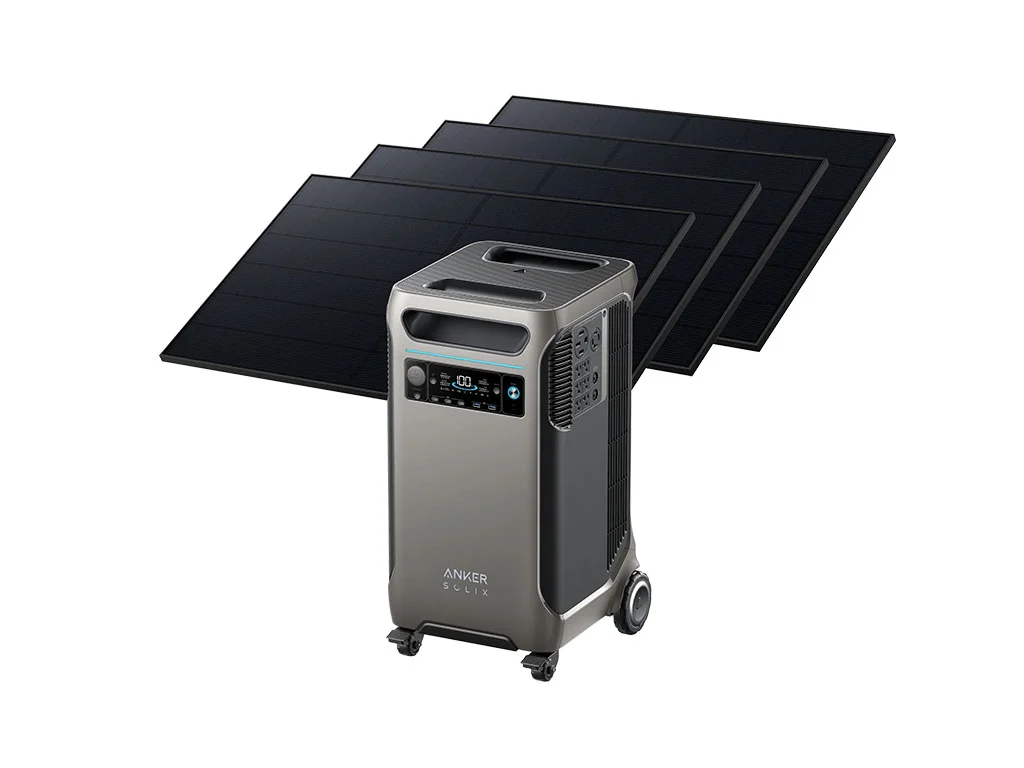
Rapid Charging: Inputs and Speeds Explained
Whether you’re on the go or facing a power outage, recharging speed is another top concern. No one wants to wait all day to recharge their unit when they need it to power important devices. The Anker Solix F3800 is designed to recharge quickly and efficiently, giving you a reliable power source even if the grid stays down.
Charging this powerhouse can be done through several methods, with AC charging and solar input being the most common. Let’s break down how each works and why speed matters:
- AC Charging: Plugging the F3800 into a standard wall outlet will recharge the unit in about 2.6 hours, thanks to its 1,800W AC input. This makes it ideal for homeowners needing a quick top-off between power outages or campers heading out on a new adventure, sucking in that last bit of shore power before they do.
- Solar Charging: The F3800 supports up to 2,400W of solar input, allowing it to fully charge in as little as 2 hours under optimal sunlight conditions. The higher the wattage of your solar panels, the faster your power station can recharge.
Our only gripe is the solar input configuration. Like many power stations, the F3800 splits up its 2,400W maximum across two inputs. This provides some flexibility, but it also means each input is less capable than you’d imagine.
For the F3800, each input has a 60V maximum. This can be limiting if you’re using large 400W panels, which can sometimes have around 35V to 40V output. Learn more about how to maximize solar inputs with our interactive tool. We also have a simple calculator for determining your solar panel needs.
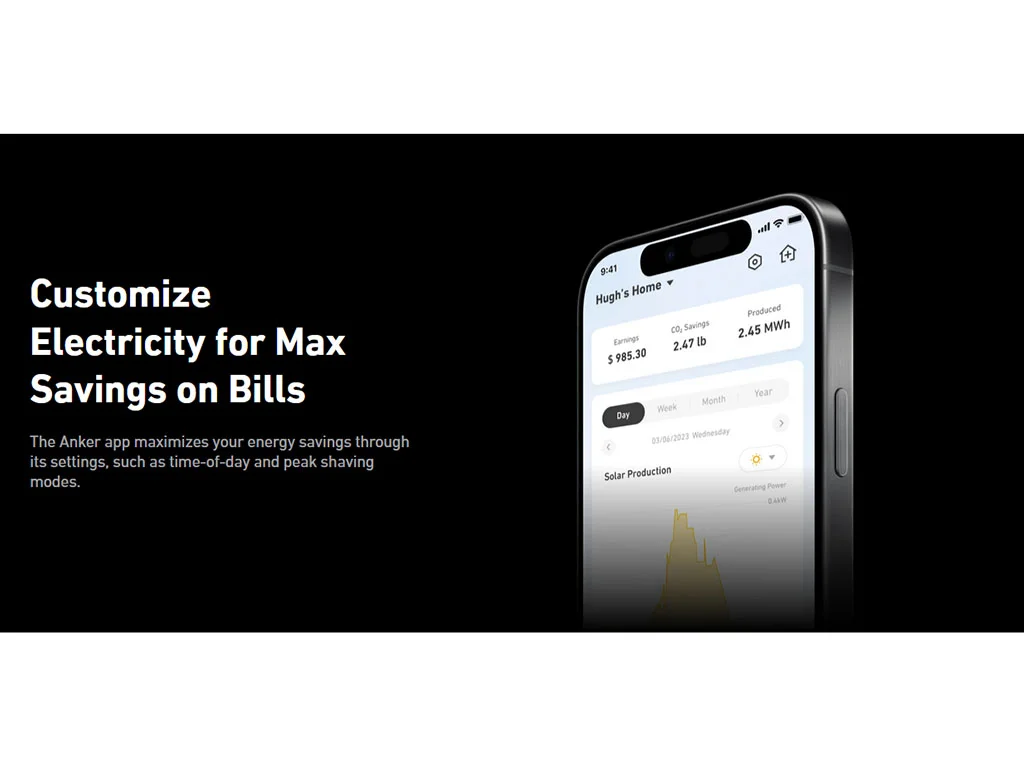
You can also use other charging methods with the F3800, including fuel generators and car charging. Here’s a look at those other off-grid power sources:
- Fuel Generators: Use gasoline or propane fuel to quickly top off the F3800’s battery then enjoy silent battery power for many hours on end. A dual solar and fuel generator is a great way to provide extra confidence while off-grid.
- Car Charging: A typical car cigarette lighter port is only 120W, so that’s not enough to help with a giant F3800 battery (taking well over a day to charge). Instead, turn to other devices like the Pecron 500W DC Car Charger to top into a higher-wattage charging solution from your RV or car engine. We have a list of other universal power station car chargers.
Charging Summary: With its multiple input options and fast charging rates, the F3800 provides users with flexibility and efficiency. The AC charging can use the full output from a standard 120V / 15A outlet, while the solar input provides a respectable figure. Getting the full 2,400W from the solar inputs can be difficult due to the 60V maximum, one downside to the F3800.
| Product | Anker Solix F3800 |
|---|---|
| AC Input | 1,800W |
| AC Recharge Hours (Est.) | 2.6h |
| Solar Input | 2,400W |
| Solar Recharge Hours (Est.) | 1.9h |
| Solar Input (System Max) | 4,800W |
| Solar Input 1 Watts | 1200W |
| Solar Input 1 Volts Min | 11V |
| Solar Input 1 Volts Max | 60V |
| Solar Input 1 Amps | 27A |
| Solar Input 2 Watts | 1200W |
| Solar Input 2 Volts Min | 11V |
| Solar Input 2 Volts Max | 60V |
| Solar Input 2 Amps | 27A |
| Buy Now | Buy Now |
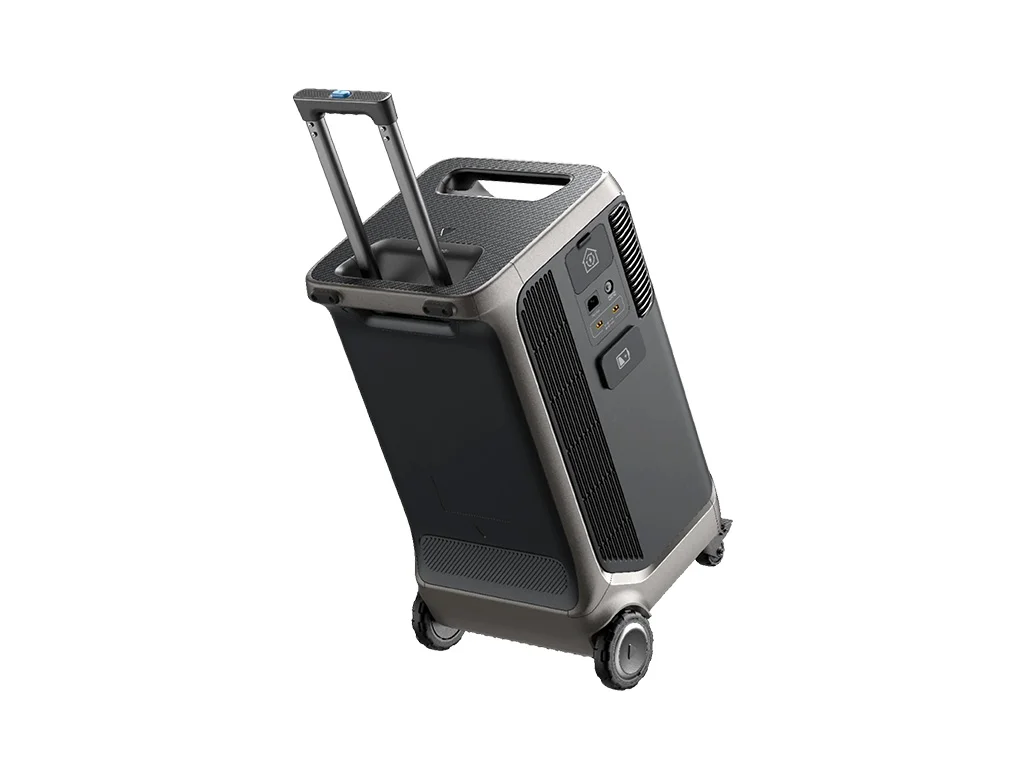
Size and Portability: Is the Anker F3800 Too Heavy?
One of the benefits of a portable power station like the Anker Solix F3800 is its mobility. Unlike DIY systems that are fixed in place, the F3800 offers the flexibility to move with you, whether you’re heading out on a road trip, an RV adventure, or moving to a new home. No matter what, you don’t have to leave it behind.
However, portability doesn’t just mean the ability to move it. You also need to think about how easily you can do so.
At 132 pounds, the F3800 is a heavyweight in the portable power station category. It has wheels and two handles (one hidden on the underside) that help with mobility. Yet there’s no doubting it’s a beast to deal with. For most people, lifting it is a two person task.
Portability Summary: Weighing in at 132 pounds, the Anker Solix F3800 is built for serious power, but that comes at the cost of easy portability. It excels as a home backup or RV power station. And you don’t have to leave it behind if you move to a new home. But power stations of this caliber are not the most convenient choice due to the unavoidable weight.
| Product | Anker Solix F3800 |
|---|---|
| Weight (lbs) | 132lbs |
| Weight (kg) | 60kg |
| Dimensions (in) | 27.6×15.3×15.6 in |
| Dimensions (mm) | 702x388x395mm |
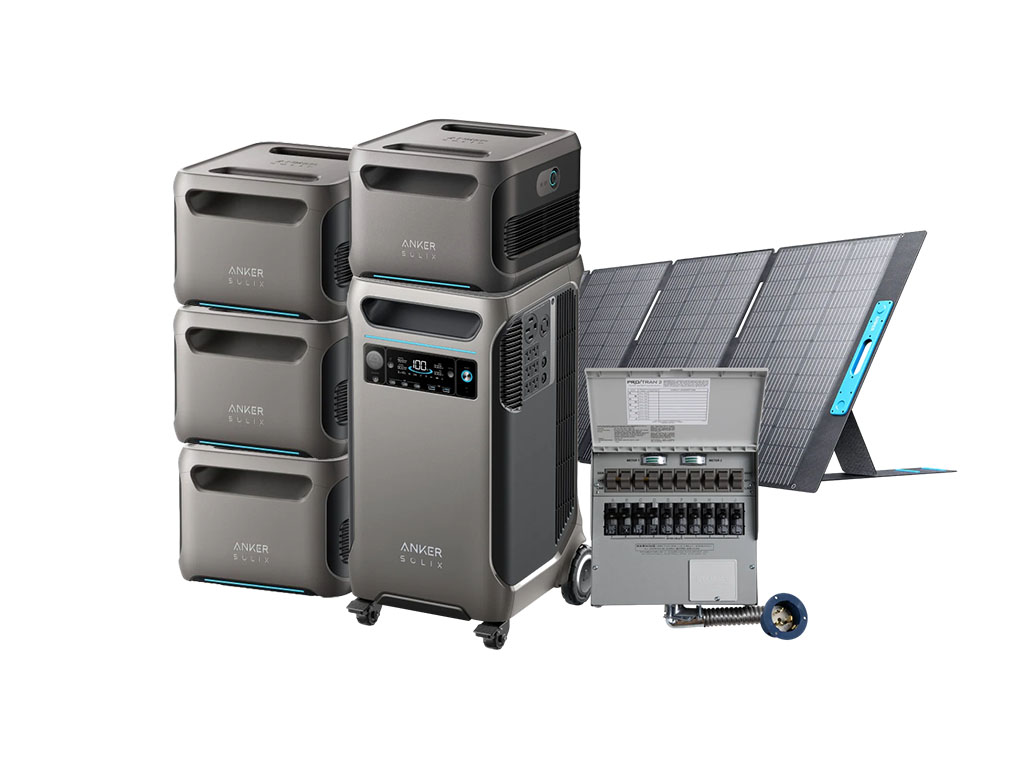
Final Thoughts: Big Investment and Bigger Power
After carefully investigating the Anker Solix F3800 with our expert knowledge, we can easily recommend this unit as a standout choice for those seeking serious energy capacity and flexibility. The core features are far beyond most others, including a whopping battery capacity that is ready to deliver many days of home backup. The inverter is extreme and it offers everything necessary to be a top-tier solution.
Here’s a quick recap of the key points we covered:
- Inverter and Outputs: With a 6,000W inverter and the ability to use two units for 12,000W total, the F3800 can handle everything from small electronics to major appliances like refrigerators and air conditioners.
- Battery Capacity: Its 3,840Wh battery is expandable up to 53,760Wh, making it ideal for extended power outages or off-grid setups.
- Charging Speeds: The F3800 charges quickly, with an AC input of 1,800W and up to 2,400W solar input, meaning you won’t wait long to get back to full power. The low voltage solar input is one limit that can prove slightly challenging to maximize the full 2,400W.
- Portability: At 132 pounds, it’s heavy but manageable for long-term setups or users who don’t need frequent mobility.
| Anker Solix F3800 |
|---|
We also love the Anker Smart Home Panel, a great way to integrate the F3800 directly into your home’s circuits. This perfectly compatible accessory goes a long way at making the Anker a great choice for whole-home battery backup needs. The high-amp outputs also serve extremely well for RV use.
Overall, the Anker Solix F3800 is a powerful solution for big energy needs. Its combination of massive battery capacity, quick charging times, and strong inverter make it perfect for homeowners, RV enthusiasts, and those seeking energy independence. It’s a worthwhile investment in your electrical stability.

|
Anker Solix F3800 Portable Power Station |
F3800 on Anker F3800 on Amazon |
Anker Solix F3800 Specs Comparison Chart
Below is a detailed comparison chart showcasing the key specs of the Anker Solix F3800, giving you a clear view of its features and performance at a glance. We also include a link to the official Anker F3800 user manual that can answer any other question you have:
| Product | Anker Solix F3800 |
|---|---|
| Battery | 3,840Wh |
| Battery (System Max) | 53,760Wh |
| AC Output | 6,000W |
| AC Output (System Max) | 12,000W |
| AC Input | 1,800W |
| AC Recharge Hours (Est.) | 2.6h |
| Solar Input | 2,400W |
| Solar Recharge Hours (Est.) | 1.9h |
| Solar Input (System Max) | 4,800W |
| Warranty | 5 years |
| Weight (lbs) | 132lbs |
| Weight (kg) | 60kg |
| Dimensions (in) | 27.6×15.3×15.6 in |
| Dimensions (mm) | 702x388x395mm |
| Solar Input 1 Watts | 1200W |
| Solar Input 1 Volts Min | 11V |
| Solar Input 1 Volts Max | 60V |
| Solar Input 1 Amps | 27A |
| Solar Input 2 Watts | 1200W |
| Solar Input 2 Volts Min | 11V |
| Solar Input 2 Volts Max | 60V |
| Solar Input 2 Amps | 27A |
| Battery Type | LiFePO4 / LFP |
| Battery Cycles | >3,000 |
| 120V Outlets | 6x20A |
| 240V Outlets | 2x25A (L14-30R & 14-50) |
| UPS / EPS | 20ms |
| USB-A Ports | 2x12W |
| USB-C Ports | 3x100W |
| Other DC (Anderson or other) | – |
| Connectivity | WiFi / Bluetooth |
| User Manual | User Manual |
| Buy Now | Buy Now |
| Buy on Amazon | F3800 on Amazon |

|
Anker Solix F3800 Portable Power Station |
F3800 on Anker F3800 on Amazon |
Key Takeaways
The Anker Solix F3800 delivers exceptional power and versatility with its large 3,840Wh battery, 6,000W inverter, and fast charging capabilities. It’s perfect for users who need a reliable backup or off-grid solution. If you’re considering a power station to solve your energy needs—whether for camping, RV living, or as a home backup—the F3800 provides the capacity and flexibility to keep you powered in any situation.
Power your home, your travels, and your adventures confidently with the right solution today! Get it now before the next storm or adventures heads your way.
See more of our most popular power station articles about the F3800:







